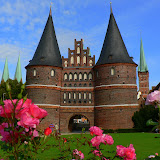Someone at Hamburg told me, by heart Germans are Communists. I am not sure if I agree with him, but Berlin is the closest I have been to a former Soviet territory. Today, all the symbols of a booming capitalist system are jostling for space with countless memorials and leftover nostalgia from the pre-unification days - and somehow I felt that robs Berlin from having a distinct character as a city. The wall is very much alive in the collective consciousness, from thousands of pieces (or so claimed) of it sold in every other souvenir shop, to "follow the wall" tours designed for history-thirsty tourists. It would probably take a while for the wall that is not there to become truly history, and before that Berlin would still be defined by that. The most popular landmark is the Brandenburg Gate, followed by a free climb upto the dome of the former Reichstag, from where again, you can see the Brandenburg Gate in all its glory and trace the path of the wall - going through the strangely constructed but eerily calm holocaust memorial at the heart of the city, all the way to Checkpoint Charlie, with people comically dressed up as commies putting commemorative stamps on your passport (for a few Euros, of course).
There is also this huge green patch at the middle of the city, somewhat of a New York city central park. I did not get enough time to explore all the churches and museums, some impressive looking, some not so. But where I did get a chance to go to was this concentration camp an hour away from the city. It was not as big or notorious as Auschwitz, but to see the barren grounds surrounded by high walls interspersed with watchtowers, houses with no windows, divided in how-can-those-be-called-rooms and the weirdly emotionless execution pit, the horrors of those days do seem up, close and personal.
The photos are, as always in my picasaweb album. I also had a chance to explore Hamburg, which is a nice harbor city, and Lubeck, which has a unique skyline with old churches and the castle-like entrance, and famous for Marzipans!
 |
| Germany - 2008 |

1 comment:
very well written, i must say :)
issh now i want to get out out gnv but dont see how
Post a Comment